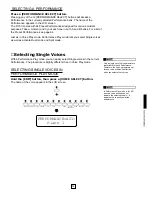
■
Panel Switch (PS)
The Panel Switch function lets you assign a function to each
of the two Panel Switches for realtime control of an external
MIDI sequencer.
This gives you the flexibility to send Start, Stop or Continue
commands to external devices like sequencers and rhythm
programmers from the P-150’s panel, i.e., you can start and
stop the external device simply by pressing the [PS]
switches.
●
PS1 ASSIGN (Off, Start, Continue, Stop)
When set to Off, the [PS1] will have no specific Play function. When set to
Start, Continue or Stop, you can control an external MIDI device by
pressing [PS1]. (The default setting for [PS1] is Start.)
●
PS2 ASSIGN
Same as for PS1 ASSIGN, above. (The default setting for [PS2] is Stop.)
If you select Sys for CONTROL in the Performance Enable function
(System menu), the Panel Switch assignment you have previously set for
the currently selected Performance may actually be different, since the
current setting (System setting) in the Voice Play mode will be active. You
can change the System setting, and you can easily find which setting
(Sys or Perf) is selected in the Performance Enable function, as the letter
P will display to the left of the page number if Perf is selected.
■
Name
The Name function lets you input a name (up to 16
characters in length) for your Performances.
●
PERFORMANCE NAME
The available characters include upper and lower case Roman letters,
numbers 0 ~ 9, a space and various symbols. Position the cursor with the
[
1
]/[
q
] buttons and choose the desired character with the [
-
1/NO]/[+1/YES]
buttons or the [DATA ENTRY] slider.
,
!
,
"
,
#
,
$
,
%
,
&
,
'
,
(
,
)
,
*
,
+
,
,
,
-
,
.
,
/
,
0
~
9
,
:
,
;
,
<
,
=
,
>
,
?
,
@
,
A
~
Z
,
[
,
,
]
,
^
,
_
,
`
,
a
~
z
{
,
|
,
}
,
›
,
‹
(Space)
50
EDIT MODE
■
Organ Combination
The Organ Combination function lets you freely edit the
Organ 1 voice. This feature gives you considerable control
over the timbre and characteristics of the organ sound, so
that the range of possibilities are practically limitless.
With this feature you can literally recreate all of the classic
organ sounds, from theatre organ to rock and jazz organ, by
adjusting the flute footage levels and the attack settings, just
like on conventional organs.
To edit the organ sound, you must first select the Organ1
voice before entering Edit mode. Otherwise the CANNOT
EDIT message will display when you select the Organ 1
Combination function in Edit mode. (If this happens, simply
exit Edit mode, select the Organ 1 voice, and then reenter
Edit mode.)
●
FOOTAGE (16’, 8’, 5-1/3’, 4’, 2-2/3’, 2’, 1-1/3’, 1’)
There are eight flute footages. The larger footages generate the
bass characteristics of the sound, the smaller footages generate
the treble characteristics of the sound, and those footages in
between generate the mid-range characteristics of the sound.
You can adjust the volume level of each flute footage between 0
(no volume) and 7 (maximum volume).
When only the lowest or highest footage is activated, some notes which
exceeds the legal range will not produce any sound.
●
RESPONSE, ATTACK (4’, 2-2/3’, 2’, Length, Mode)
The left-most parameter, RSP (Response) determines how fast
the overall organ combination (footages in page 1) volume
reaches maximum level, between a range of 0 (fastest) and 7
(slowest). There are three Attack footages which determine the
character of the percussive portion of the organ voice. You can
adjust the volume level of each Attack footage between 0 (no
volume) and 7 (maximum volume).
PS1 ASSIGN 1
start:FA
PERF.NAME 1
PERFORMANCE<***>
COMBI. 16'=7 1
■ ■ ■ ■ ■ ■ ■ ■
16'
8'
5-1/3'
4'
2-2/3'
2'
1-1/3'
1'
COMBI. RESP.=7 2
RSP
■ ■ ■ ■ ■
E
Response
PS2 ASSIGN 2
stop:FC
COMBI. LENG.=3 2
ATK
■ ■ ■ ■ ■
E
Attack Length
COMBI. 4'=7 2
ATK
■ ■ ■ ■ ■
E
4'
2-2/3'
2'
Attack Footages












































